| Raikoji Temple (来迎寺) |
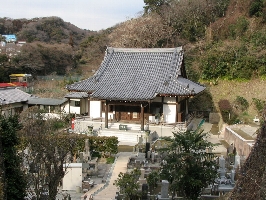
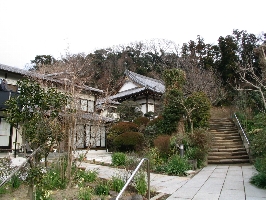
Full name: Mankozan Raikoji (満光山来迎寺)
Denomination: Ji sect (時宗)
Location: One and a half kilometers northeast of JR Kamakura Station, and to the northeast of Hachimangu Shrine grounds.
History: The temple is said to have been built in the 1280s by Ippen (一遍, 1239-89), the founder of the Ji sect (時宗) of Buddhism. The Main Hall was destroyed by the Great Kanto Earthquake of 1923 but was re-built in 1994.
Grounds: The temple structures sit on the open space on the hillside. The main hall houses a seated image of Amida Nyorai in the center, and a statue of Jizo Bosatsu (an Important Cultural Property by Kanagawa Prefecture) supposedly carved by Takuma Joko (宅間浄宏) in 1384. Nyoirin Kannon (如意輪観音) on the right of the main image is a work of the Nambokucho period (1336-92). The statue has colorfully painted decorative clay patterns and, is designated an Important Cultural Property by Kanagawa Prefecture.
The statue to the left of the main image is Badabarasonja (抜陀婆羅尊者), a statue that allegedly cures pain in the feet, legs and waist. Other possessions include a sambutsuzo (三仏像) triad, a waniguchi (鰐口) gong, literally, "crocodile mouth," and a tearai-ishi (手洗い石), a stone hand-washing basin.
Legend: A sad story about the Nyoirin Kannon tells about a man in Yui (由比), who was living a luxurious life, with not a care in the world. The man had a daughter he loved very much, but one day a large eagle swooped down and carried her off. The father frantically searched for his daughter, and although he eventually found her, she was dead. He interred her remains inside the body of this Kannon for the repose of her soul.
| The Site of Okura bakufu (大倉幕府跡) |
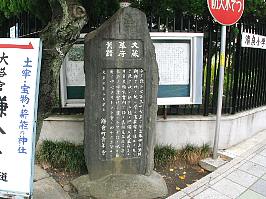 This area, Okura, was the center of the Kamakura government in its first stage. In 1180, Minamoto
Yoritomo entered Kamakura and established his government in this vicinity, calling it the Okura bakufu. He
also had his residence built here. The government went on to function here for 46 years until it was
transferred to a location near Wakamiya-oji Avenue.
This area, Okura, was the center of the Kamakura government in its first stage. In 1180, Minamoto
Yoritomo entered Kamakura and established his government in this vicinity, calling it the Okura bakufu. He
also had his residence built here. The government went on to function here for 46 years until it was
transferred to a location near Wakamiya-oji Avenue.
| The Tomb of Minamoto no Yoritomo (源頼朝の墓) |
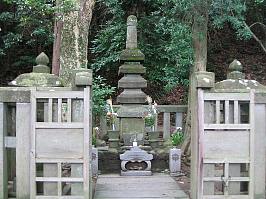 This is the tomb of Minamoto no Yoritomo, the founder of the Kamakura bakufu. He was born in 1147 and
died on January 13, 1199 at the age of 52. At the foot of this hill, there used to be a temple called
Hokkedo, built at the order of Yoritomo himself, and it is said he used to worship here daily. The shrine
on the left side of the stone steps is Shirahata Jinja, literally, the White Banner Shrine. The white
banner was the symbol of Yoritomo's family, Minamoto, which is also known as Genji. The shrine itself was
built in the early Meiji period.
This is the tomb of Minamoto no Yoritomo, the founder of the Kamakura bakufu. He was born in 1147 and
died on January 13, 1199 at the age of 52. At the foot of this hill, there used to be a temple called
Hokkedo, built at the order of Yoritomo himself, and it is said he used to worship here daily. The shrine
on the left side of the stone steps is Shirahata Jinja, literally, the White Banner Shrine. The white
banner was the symbol of Yoritomo's family, Minamoto, which is also known as Genji. The shrine itself was
built in the early Meiji period.
| The Tomb of Oe no Hiromot (大江広元の墓) |
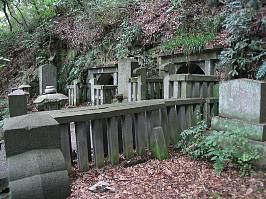 This is the tomb of Oe no Hiromoto. He was invited by Minamoto Yoritomo from Kyoto to act as an
adviser in the establishment of the Kamakura bakufu. His contributions are said to have been so great that
the new political system was set in place earlier than expected.
This is the tomb of Oe no Hiromoto. He was invited by Minamoto Yoritomo from Kyoto to act as an
adviser in the establishment of the Kamakura bakufu. His contributions are said to have been so great that
the new political system was set in place earlier than expected.
| The site of Hokkedo Hall (法華堂跡) |
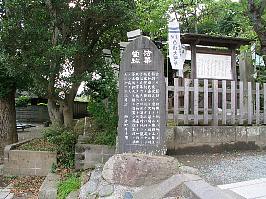 A stone monument marking the site of the Hokkedo hall stands at the foot of the hill where the tomb
of Minamoto no Yoritomo is located. The hall was built on the personal order of Yoritomo and installed with
Buddhist images, so he could worship here everyday.
A stone monument marking the site of the Hokkedo hall stands at the foot of the hill where the tomb
of Minamoto no Yoritomo is located. The hall was built on the personal order of Yoritomo and installed with
Buddhist images, so he could worship here everyday.The hall was also the scene of a gruesome incident in 1247. This was at a time when the Hojo clan was setting up its dictatorship, eliminating one rival clan after another. The Miura clan was the last target to be annihilated. On June 5, 1247, the Hojo forces led by Adachi Kagemori attacked the Miura residence. After a fierce battle, the Miura were defeated and forced to retreat into the Hokkedo hall. Here the remaining members of the Miura clan committed suicide in front of an image of Minamoto Yoritomo. The scene was witnessed by a monk who had taken refuge from the battle and hidden in the ceiling above.